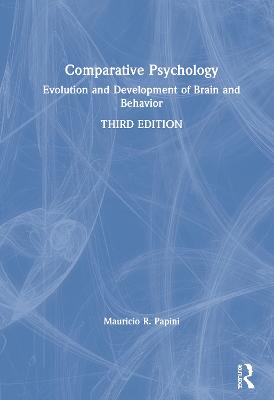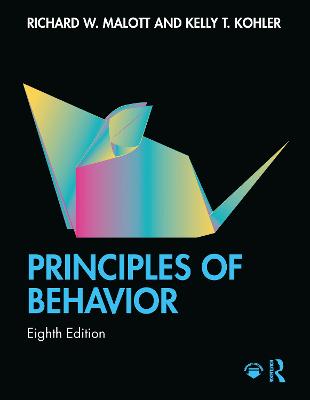Comparative Psychology
 -10%
portes grátis
-10%
portes grátis
Comparative Psychology
Evolution and Development of Brain and Behavior, 3rd Edition
Papini, Mauricio
Taylor & Francis Ltd
10/2020
536
Dura
Inglês
9781138788145
15 a 20 dias
453
Descrição não disponível.
1. Biological Evolution
1.1 Evidence for Evolution
1.2 Logic of Natural Selection
1.3 Origin and Preservation of Genetic Variability
1.4 Natural Selection
1.5 Glossary
1.6 References
2. Origin and Evolution of Animals
2.1 Diversity of Life
2.2 Geological Background
2.3 Origin and Evolution of Animals
2.4 Speciation
2.5 Grades and Clades
2.6 Glossary
2.7 References
3. Evo-devo, Brain, and Behavior
3.1 Definitions
3.2 Early Development
3.3 Development of the Vertebrate Nervous System
3.4 Development and evolution
3.5 Terminology
3.6 Behavior
3.7 Glossary
3.8 References
4. Simple Nervous Systems and Behavior
4.1 Invertebrate Phyla
4.2 Behavior and Simple Neural Networks
4.3 Behavioral and Neural Plasticity in Nonassociative Learning
4.4 Evolution of Learning Mechanisms in Mollusks
4.5 Glossary
4.6 References
5. Evolution of the Vertebrate Brain and Behavior
5.1 Key Innovations of Vertebrates
5.2 Comparative Neurology
5.3 Telencephalon
5.4 Brain Size
5.5 Glossary
5.6 References
Chapter 6: Fundamentals of Learning and Cognition
6.1 Definitions
6.2 Forms of Conditioning
6.3 Classical Conditioning
6.4 Instrumental Conditioning
6.5 Situational Generality of Associative Learning
6.6 Brain Mechanisms of Learning and Cognition: An Overview
6.7 Glossary
6.8 References
7. Comparative Analysis of Learning and Cognition
7.1 Comparative Methodology
7.2 Learning and Cognition in Invertebrates
7.3 Learning and Cognition as Adaptations
7.4 Learning, Cognition, and Phylogenetic History
7.5 Glossary
7.6 References
8. Higher Cognitive Processes
8.1 From Associative Learning to Cognition
8.2 From Concepts to Social Cognition
8.3 Mental Continuity and Discontinuity
8.4 Glossary
8.5 References
9. Early Learning and Behavior
9.1 Ontogenetic Transitions
9.2 Prenatal and Prehatching Behavior
9.3 Infant Behavior
9.4 Infant Learning
9.5 Development of Complex Behavior
9.6 Glossary
9.7 References
10. Early Social Learning and Behavior
10.1 From Individual to Social Behavior
10.2 Imprinting
10.3 Reproductive and Social Behavior
10.4 Development of Vocal Behavior
10.5 Glossary
10.6 References
11. Reproductive and Social Behavior
11.1 Reproductive Biology and Social Behavior
11.2 Mechanisms Underlying Social Behavior
11.3 Mating Systems
11.4 Patterns of Reproductive Behavior
11.5 Infant Care
11.6 Complex Animal Societies
11.7 Glossary
11.8 References
12. Brain, Behavior, and Evolution of Primates
12.1 What is a Primate?
12.2 The Primate Brain
12.3 Evolution of Language
12.4 Origin of Primates
12.5 Hominids
12.6 From Archaic to Modern Humans
12.7 Conclusion: From Oldowan Tools to Climate Change
12.8 Glossary
12.9 References
1.1 Evidence for Evolution
1.2 Logic of Natural Selection
1.3 Origin and Preservation of Genetic Variability
1.4 Natural Selection
1.5 Glossary
1.6 References
2. Origin and Evolution of Animals
2.1 Diversity of Life
2.2 Geological Background
2.3 Origin and Evolution of Animals
2.4 Speciation
2.5 Grades and Clades
2.6 Glossary
2.7 References
3. Evo-devo, Brain, and Behavior
3.1 Definitions
3.2 Early Development
3.3 Development of the Vertebrate Nervous System
3.4 Development and evolution
3.5 Terminology
3.6 Behavior
3.7 Glossary
3.8 References
4. Simple Nervous Systems and Behavior
4.1 Invertebrate Phyla
4.2 Behavior and Simple Neural Networks
4.3 Behavioral and Neural Plasticity in Nonassociative Learning
4.4 Evolution of Learning Mechanisms in Mollusks
4.5 Glossary
4.6 References
5. Evolution of the Vertebrate Brain and Behavior
5.1 Key Innovations of Vertebrates
5.2 Comparative Neurology
5.3 Telencephalon
5.4 Brain Size
5.5 Glossary
5.6 References
Chapter 6: Fundamentals of Learning and Cognition
6.1 Definitions
6.2 Forms of Conditioning
6.3 Classical Conditioning
6.4 Instrumental Conditioning
6.5 Situational Generality of Associative Learning
6.6 Brain Mechanisms of Learning and Cognition: An Overview
6.7 Glossary
6.8 References
7. Comparative Analysis of Learning and Cognition
7.1 Comparative Methodology
7.2 Learning and Cognition in Invertebrates
7.3 Learning and Cognition as Adaptations
7.4 Learning, Cognition, and Phylogenetic History
7.5 Glossary
7.6 References
8. Higher Cognitive Processes
8.1 From Associative Learning to Cognition
8.2 From Concepts to Social Cognition
8.3 Mental Continuity and Discontinuity
8.4 Glossary
8.5 References
9. Early Learning and Behavior
9.1 Ontogenetic Transitions
9.2 Prenatal and Prehatching Behavior
9.3 Infant Behavior
9.4 Infant Learning
9.5 Development of Complex Behavior
9.6 Glossary
9.7 References
10. Early Social Learning and Behavior
10.1 From Individual to Social Behavior
10.2 Imprinting
10.3 Reproductive and Social Behavior
10.4 Development of Vocal Behavior
10.5 Glossary
10.6 References
11. Reproductive and Social Behavior
11.1 Reproductive Biology and Social Behavior
11.2 Mechanisms Underlying Social Behavior
11.3 Mating Systems
11.4 Patterns of Reproductive Behavior
11.5 Infant Care
11.6 Complex Animal Societies
11.7 Glossary
11.8 References
12. Brain, Behavior, and Evolution of Primates
12.1 What is a Primate?
12.2 The Primate Brain
12.3 Evolution of Language
12.4 Origin of Primates
12.5 Hominids
12.6 From Archaic to Modern Humans
12.7 Conclusion: From Oldowan Tools to Climate Change
12.8 Glossary
12.9 References
Este título pertence ao(s) assunto(s) indicados(s). Para ver outros títulos clique no assunto desejado.
Instrumental Conditioning;natural;License Cc;selection;Played Back;successive;Fear Conditioning;negative;Imprinting Stimulus;contrast;Spinal Cord;artificial;GWR;experiments;Inhibitory Conditioning;fear;Short Term Sensitization;conditioning;Short Term Habituation;reproductive;Adjunctive Behaviors;animal psychology;Filial Imprinting;animal learning;Abdominal Ganglion;evolutionary-developmental framework;Relative Brain Size;comparative psychology;Zebra Finches;central nervous system;SN;human ancestors;Sensory Neurons;Long Term Habituation;Command Neuron;Dishabituating Stimulus;Cranial Capacity;Hox Genes;CPG;Habituating Stimulus;Eusocial Species
1. Biological Evolution
1.1 Evidence for Evolution
1.2 Logic of Natural Selection
1.3 Origin and Preservation of Genetic Variability
1.4 Natural Selection
1.5 Glossary
1.6 References
2. Origin and Evolution of Animals
2.1 Diversity of Life
2.2 Geological Background
2.3 Origin and Evolution of Animals
2.4 Speciation
2.5 Grades and Clades
2.6 Glossary
2.7 References
3. Evo-devo, Brain, and Behavior
3.1 Definitions
3.2 Early Development
3.3 Development of the Vertebrate Nervous System
3.4 Development and evolution
3.5 Terminology
3.6 Behavior
3.7 Glossary
3.8 References
4. Simple Nervous Systems and Behavior
4.1 Invertebrate Phyla
4.2 Behavior and Simple Neural Networks
4.3 Behavioral and Neural Plasticity in Nonassociative Learning
4.4 Evolution of Learning Mechanisms in Mollusks
4.5 Glossary
4.6 References
5. Evolution of the Vertebrate Brain and Behavior
5.1 Key Innovations of Vertebrates
5.2 Comparative Neurology
5.3 Telencephalon
5.4 Brain Size
5.5 Glossary
5.6 References
Chapter 6: Fundamentals of Learning and Cognition
6.1 Definitions
6.2 Forms of Conditioning
6.3 Classical Conditioning
6.4 Instrumental Conditioning
6.5 Situational Generality of Associative Learning
6.6 Brain Mechanisms of Learning and Cognition: An Overview
6.7 Glossary
6.8 References
7. Comparative Analysis of Learning and Cognition
7.1 Comparative Methodology
7.2 Learning and Cognition in Invertebrates
7.3 Learning and Cognition as Adaptations
7.4 Learning, Cognition, and Phylogenetic History
7.5 Glossary
7.6 References
8. Higher Cognitive Processes
8.1 From Associative Learning to Cognition
8.2 From Concepts to Social Cognition
8.3 Mental Continuity and Discontinuity
8.4 Glossary
8.5 References
9. Early Learning and Behavior
9.1 Ontogenetic Transitions
9.2 Prenatal and Prehatching Behavior
9.3 Infant Behavior
9.4 Infant Learning
9.5 Development of Complex Behavior
9.6 Glossary
9.7 References
10. Early Social Learning and Behavior
10.1 From Individual to Social Behavior
10.2 Imprinting
10.3 Reproductive and Social Behavior
10.4 Development of Vocal Behavior
10.5 Glossary
10.6 References
11. Reproductive and Social Behavior
11.1 Reproductive Biology and Social Behavior
11.2 Mechanisms Underlying Social Behavior
11.3 Mating Systems
11.4 Patterns of Reproductive Behavior
11.5 Infant Care
11.6 Complex Animal Societies
11.7 Glossary
11.8 References
12. Brain, Behavior, and Evolution of Primates
12.1 What is a Primate?
12.2 The Primate Brain
12.3 Evolution of Language
12.4 Origin of Primates
12.5 Hominids
12.6 From Archaic to Modern Humans
12.7 Conclusion: From Oldowan Tools to Climate Change
12.8 Glossary
12.9 References
1.1 Evidence for Evolution
1.2 Logic of Natural Selection
1.3 Origin and Preservation of Genetic Variability
1.4 Natural Selection
1.5 Glossary
1.6 References
2. Origin and Evolution of Animals
2.1 Diversity of Life
2.2 Geological Background
2.3 Origin and Evolution of Animals
2.4 Speciation
2.5 Grades and Clades
2.6 Glossary
2.7 References
3. Evo-devo, Brain, and Behavior
3.1 Definitions
3.2 Early Development
3.3 Development of the Vertebrate Nervous System
3.4 Development and evolution
3.5 Terminology
3.6 Behavior
3.7 Glossary
3.8 References
4. Simple Nervous Systems and Behavior
4.1 Invertebrate Phyla
4.2 Behavior and Simple Neural Networks
4.3 Behavioral and Neural Plasticity in Nonassociative Learning
4.4 Evolution of Learning Mechanisms in Mollusks
4.5 Glossary
4.6 References
5. Evolution of the Vertebrate Brain and Behavior
5.1 Key Innovations of Vertebrates
5.2 Comparative Neurology
5.3 Telencephalon
5.4 Brain Size
5.5 Glossary
5.6 References
Chapter 6: Fundamentals of Learning and Cognition
6.1 Definitions
6.2 Forms of Conditioning
6.3 Classical Conditioning
6.4 Instrumental Conditioning
6.5 Situational Generality of Associative Learning
6.6 Brain Mechanisms of Learning and Cognition: An Overview
6.7 Glossary
6.8 References
7. Comparative Analysis of Learning and Cognition
7.1 Comparative Methodology
7.2 Learning and Cognition in Invertebrates
7.3 Learning and Cognition as Adaptations
7.4 Learning, Cognition, and Phylogenetic History
7.5 Glossary
7.6 References
8. Higher Cognitive Processes
8.1 From Associative Learning to Cognition
8.2 From Concepts to Social Cognition
8.3 Mental Continuity and Discontinuity
8.4 Glossary
8.5 References
9. Early Learning and Behavior
9.1 Ontogenetic Transitions
9.2 Prenatal and Prehatching Behavior
9.3 Infant Behavior
9.4 Infant Learning
9.5 Development of Complex Behavior
9.6 Glossary
9.7 References
10. Early Social Learning and Behavior
10.1 From Individual to Social Behavior
10.2 Imprinting
10.3 Reproductive and Social Behavior
10.4 Development of Vocal Behavior
10.5 Glossary
10.6 References
11. Reproductive and Social Behavior
11.1 Reproductive Biology and Social Behavior
11.2 Mechanisms Underlying Social Behavior
11.3 Mating Systems
11.4 Patterns of Reproductive Behavior
11.5 Infant Care
11.6 Complex Animal Societies
11.7 Glossary
11.8 References
12. Brain, Behavior, and Evolution of Primates
12.1 What is a Primate?
12.2 The Primate Brain
12.3 Evolution of Language
12.4 Origin of Primates
12.5 Hominids
12.6 From Archaic to Modern Humans
12.7 Conclusion: From Oldowan Tools to Climate Change
12.8 Glossary
12.9 References
Este título pertence ao(s) assunto(s) indicados(s). Para ver outros títulos clique no assunto desejado.
Instrumental Conditioning;natural;License Cc;selection;Played Back;successive;Fear Conditioning;negative;Imprinting Stimulus;contrast;Spinal Cord;artificial;GWR;experiments;Inhibitory Conditioning;fear;Short Term Sensitization;conditioning;Short Term Habituation;reproductive;Adjunctive Behaviors;animal psychology;Filial Imprinting;animal learning;Abdominal Ganglion;evolutionary-developmental framework;Relative Brain Size;comparative psychology;Zebra Finches;central nervous system;SN;human ancestors;Sensory Neurons;Long Term Habituation;Command Neuron;Dishabituating Stimulus;Cranial Capacity;Hox Genes;CPG;Habituating Stimulus;Eusocial Species







